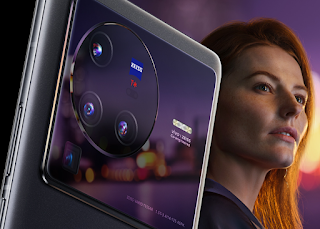Vivo X80 Pro - design, build quality, ease of use
Vivo X80 Pro Vivo is a smartphone with high-end cameras. Advanced photo modules, help from German Zeiss engineers, super-stabilized picture comparable to a gimbal, a matrix built particularly for Vivo in the basic module, and its own image processing are only the top of the photographic and technical iceberg that slammed the camera of the new Vivo X80 Pro.
 |
| Vivo |
Vivo X80 Pro - design, build quality, ease of use
Vivo's top X series models (X51 Pro, X60 Pro, and X70 Pro) are sleek, subtle-looking, light, and comfortable to use. The new X80 Pro can't be packaged with the same elegance. Particularly its back.
Right side of camera has enormous unused rectangle. Vivo stylists also placed an asymmetrical circle in a big rectangle, where just three camera modules are located. For symmetry, we replaced the fourth eyelet with the Zeiss logo, a mobile photography partner of Vivo. The fourth periscope tele module located on the camera island's lower left. It's a stylistic hodgepodge. Perhaps it was forced by structural issues with placing such an advanced camera portion, but it lacks beauty.
The X80 Pro camera island is larger than the Xiaomi Mi 11 Ultra camera part with an extra screen. This approach prevents the phone from wobbling on a flat surface.
The smartphone's matte, rough glass rear cover doesn't accumulate fingerprints, even in black (glossy camera section - on the contrary). Many will appreciate Vivo's waterproof flagship ( IP68 ).
The X80 Pro's matte back can surprise itself in high light, creating a unique artistic impact. Surprisingly, the rear panel is more slipperier than traditional glass.
The Vivo X80 Pro is taller, wider, thicker, and 36 grammes heavier than the Vivo X60 Pro. The phone is 165 x 75.9 x 11.6 mm (9.6 mm without the camera protrusion) and 223 grammes (237 grammes with the company case). The new flagship Vivo has a 6.68-inch, 120 Hz, QHD+ AMOLED screen manufactured using LTPO technology. Folded sides make the panel lighter.
Under the screen is a big ultrasonic fingerprint reader (about 2 x 3 centimeters). It allows you to easily and securely unlock your smartphone, as well as register and utilise two fingerprints at once for added protection - a bit excessive for the average user, but the idea is interesting.
Right side of frame has switch and volume control. We won't have trouble getting a finger on the X80 Pro despite its size. Comfortable height.
According to the manufacturer, the top of the housing is embellished with a plastic inlay reading professional photography. We already know this accent from prior X series devices, but I hate that the Vivo can't break out of it - even if it would make the housing structure more complex by requiring new antenna placement. This plastic doesn't match the rest of the housing. Let it not appear that I exclusively criticise Vivo... Xiaomi utilised the same method in the Mi 11 Ultra. Xiaomi 12 series this year doesn't have it.
The plastic insert also hides a microphone aperture and an IrDA port.
Lower frame is aluminium, thankfully. Here we see the main speaker grill from the stereo audio system (the second plays music through the headphone slot), the main microphone opening, the USB 3.1 type C socket, and a card tray that can hold two Nano SIM modules. Vivo X80 Pro has no card slot or headphone jack. Wire USB headphones come with the phone. Today, factory-set accessories are rare.
Factory Equipment
What's in the Vivo X80 Pro package besides USB headphones? A 80 W charger, a USB cable, a plastic cover to protect the phone's back and corners, and a SIM card tray ejector are included.
Speaker and headphone quality
The X80 Pro stereo audio system includes a wide-range bottom speaker and a quieter, smaller top driver. Such a combination creates a stereo effect but lacks volume symmetry. The sound is too flat and harsh for this type of smartphone. Xiaomi 12 Pro's audio system isn't dramatically better than the X80 Pro's, but it sounds richer and more balanced.
The provided headphones sound bass-heavy, with muffled middle and boosted treble. It's not a flagship headset, but for on-the-go listening, it's fine. Light and snug headphones are a plus.
We can connect minijack headphones to the X80 Pro's USB port with a cheap, passive adapter (not provided).
The Vivo X80 Pro lacks a graphic equaliser. We have a technology that improves sound from lossy compressed files, sound optimization when using Vivo and IQOO headphones, and sound calibration based on our hearing and the headphones used. It takes time and effort, but it's worthwhile.
Vivo X80 Pro - technical specifications, performance, battery
Snapdragon 8 Gen 1 is the only chipset for flagship phones. It can and is overall. On the Chinese market, Vivo X80 Pro also comes with a MediaTek Dimensity 9000 chip, and I'd be pleased to compare both models. I'm intrigued in the Chinese edition's ceramic housing.
For now, let's stick with the European version, which has 12 GB of RAM, 256 GB of data storage, 5G modem, Wi-Fi 6E card, Bluetooth 5.2 module, and NFC module.
The smartphone runs Android 12 with Funtouch OS's functional enhancements. Vivo has so far kept up with Android updates, which were dated June 2022.



Comments
Post a Comment